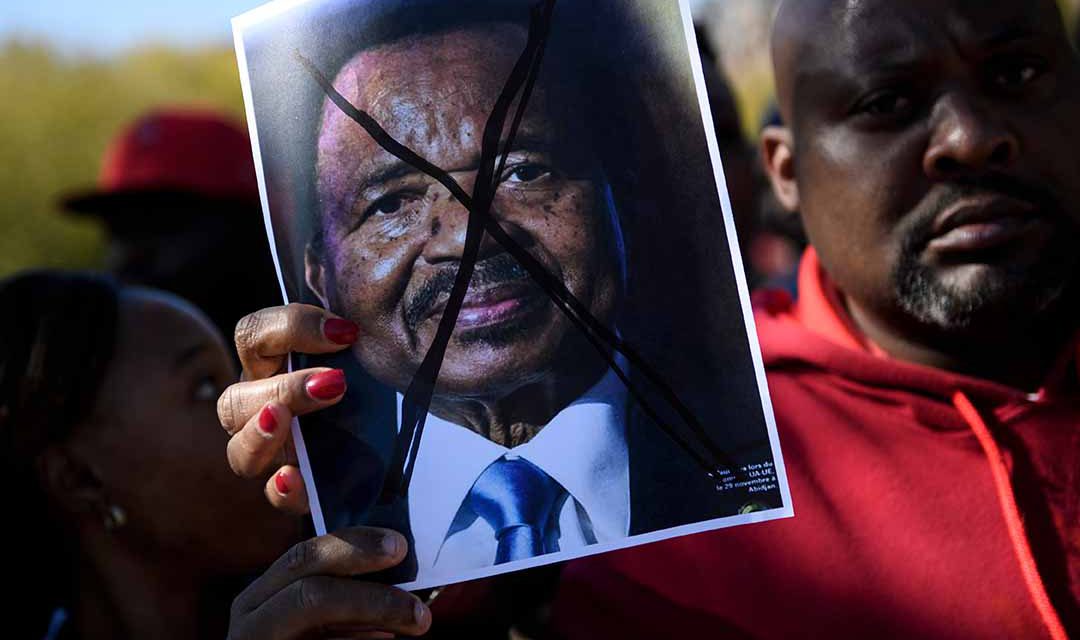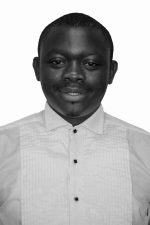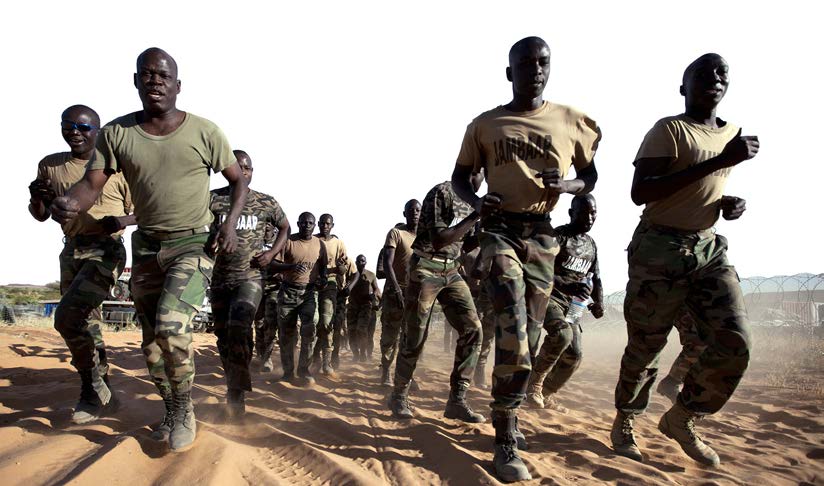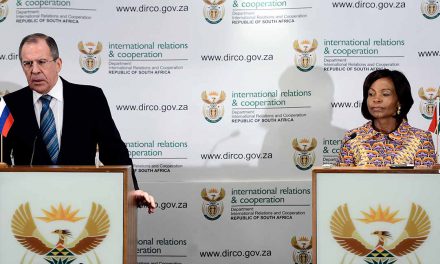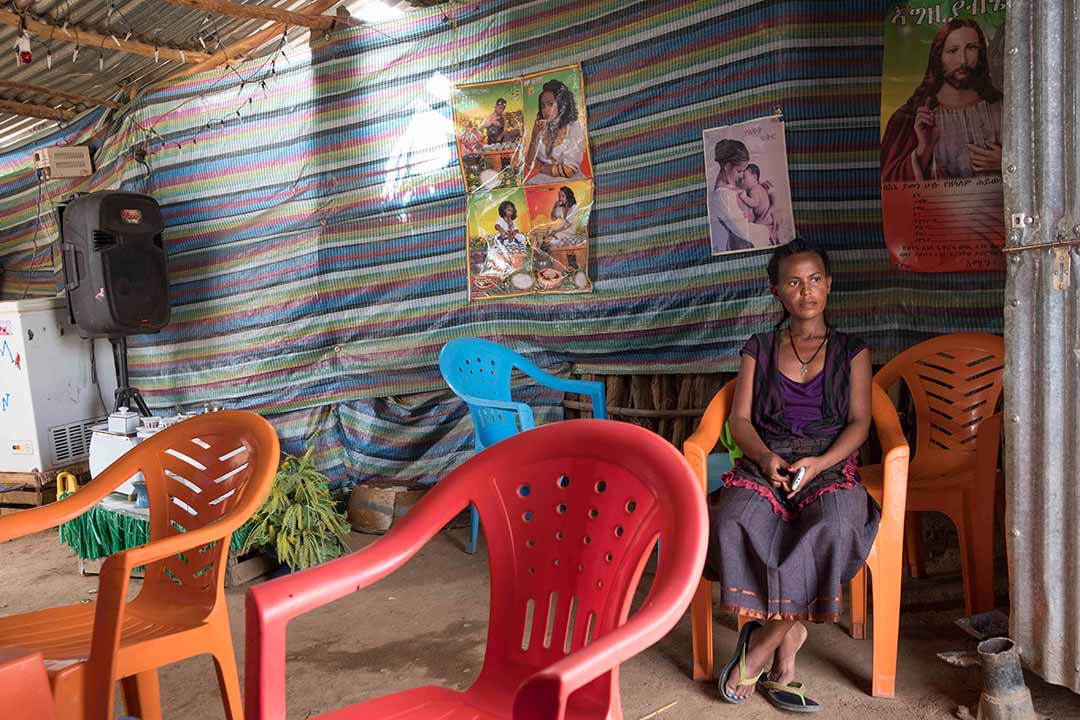Cameroon: the deadly cycle
A steady flow of weapons is fuelling the vicious conflict between Cameroon’s Anglophone regions and the government
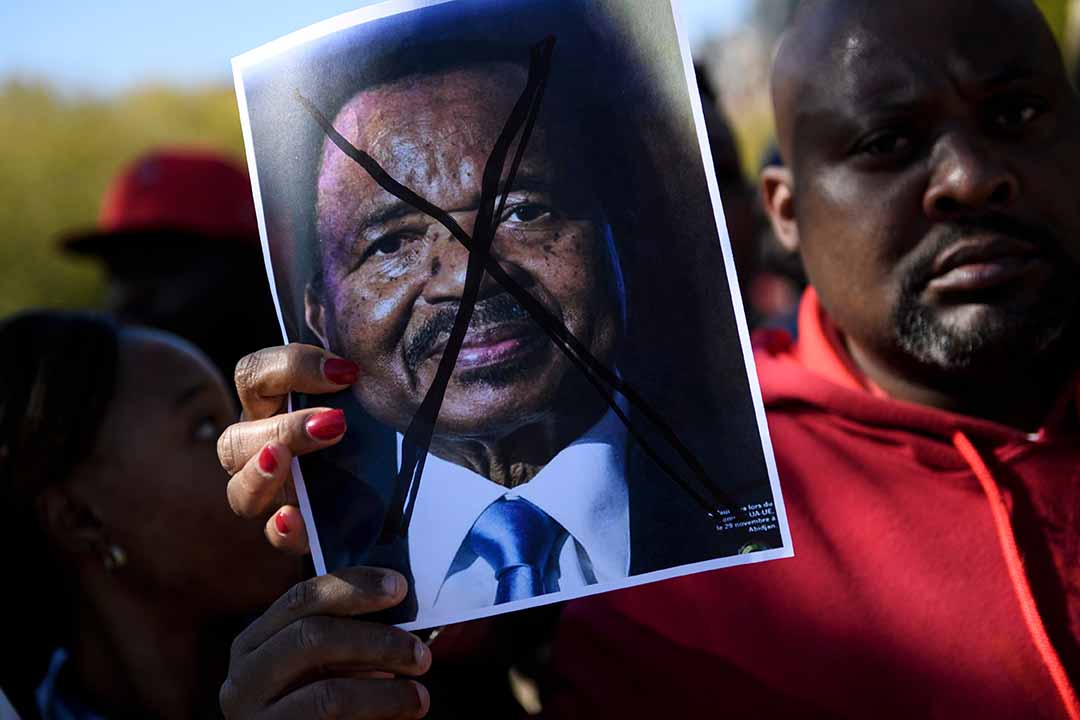
People protest against Cameroon President Paul Biya on Pennsylvania Avenue near the White House in October 2018. Photo: BRENDAN SMIALOWSKI / AFP
Over the past four years, Cameroon has descended into violence. The central African nation is presently in the throes of the worst internal armed conflict since independence in 1961. A raging conflict in Cameroon’s English speaking regions has left President Paul Biya, 86 – who has been in power since 1982, long before 60% of the country’s 24 million people were born – in a fix. Biya’s government has yet to take measures to stop the deadly conflict. Rather, by using its armed forces, it has escalated it. The conflict in the English-speaking North West and South West regions of Cameroon snowballed into violence in late 2017, but the origins of the conflict can be traced back to colonial power dealings in the 19th century involving Britain and France and, at one point, Germany.
Modern day Cameroon was born out of Kamerun, which Germany annexed on 5 July, 1884. Following Germany’s defeat in the first world war, three quarters of the territory went to France, which was called French Cameroun, while the rest became two separate regions, British Southern Cameroons and British Northern Cameroons. The 1919 partition was the beginning of trouble and marked the semipermanent divide among Cameroonians today. Following independence in 1960/1, Cameroon maintained the French and English systems inherited from its two respective colonisers. The country was split from the onset, based on colonial heritages. As a result, it has been running two separate systems – be it legal, educational, governmental, or other spheres of national life.
According to Verkijika G Fanso, a history professor at the University of Yaounde I, the prevailing animosity is essentially between English-speaking Cameroonians and the government, led and dominated by French-speaking Cameroonians. “They have ruled the country in an authoritarian way since the unification of the two former United Nations (UN) trusteeship territories – French Cameroun and British Southern Cameroons – in 1961. The dignity and statehood of Anglophones was silently destroyed,” Fanso told The Conversation in October 2017. A Francophone majority changed the constitution to a unitary state in a 1972 referendum. The name of the country was also changed in 1984 by a presidential decree from the United Republic of Cameroon (adopted in 1972) to the Republic of Cameroon – the initial name of former French Cameroon at independence.
These developments, among others, have increasingly pushed Anglophones to the wall. From time to time, they have sought autonomy – buttressed by an April 1961 UN resolution, which outlines the unification of the two territories as a federation of two states of equal status and autonomy. Fast forward to late 2016, when English speaking lawyers opposed the appointment of French-educated judges, trained in civil law, to their courts. They complained that the judges had not mastered the English language or the English legal system, which is based on common law. The aggrieved lawyers also wanted certain legal instruments translated into English, particularly the Uniform Act adopted by the Organisation for the Harmonisation of Business Law in Africa, which has 17 member states in west and central Africa and regulates corporate business between them. English teachers then joined the protest.
One of their grievances was the government’s “harmonisation” of the Anglophone and Francophone sub-systems of education, which has seen French teachers with little or no appropriate language competencies transferred to English schools. Lawyers and teachers in the English speaking regions declared an indefinite work stoppage, in an attempt to force the government to yield to their demands. But the government responded with force. Modest demonstrations spiralled into mass protests, which were met with mass arrests by security forces. Between December 2016 and January 2017, government engaged the lawyers and teachers in talks, but with no result. Leaders were arrested and thrown in jail, while others went into exile. The region’s internet was also switched off for 230 days between January 2017 and March 2018.
These actions led many moderates in the Anglophone community to support more radical measures, such as greater autonomy, federalism and even secession. The government has not continued negotiations, and does not appear to want an end to the conflict. On 1 October, 2017 the newly created Southern Cameroons Ambazonia Consortium United Front, consisting of several separatist movements, declared the independence of the former West Cameroon, naming it the Federal Republic of Ambazonia (Southern Cameroons). But the Cameroon government brutally crushed protests held to mark the day, in what the UN described as “excessive use of force”. This, in turn, fanned the emergence of small armed resistance groups, which later gained popularity and manpower. By the end of the year, Biya had reiterated his intent to act against resistance groups.
Since then running battles between the heavily equipped regular army and increasingly bold armed separatists have left a trail of destruction. The UN High Commission for Refugees (UNHCR) reports that 42,610 refugees fleeing violence in the English-speaking regions were registered in Nigeria by August 2018 – some 53% of them women. The past three years have been a particularly difficult one for women and girls in the English-speaking regions of Cameroon. Violent clashes between the two warring parties have left women even more vulnerable as soft targets for soldiers, armed separatist fighters and criminal gangs. Many women and girls are the victims of sexual abuse, but many rape cases go unreported, with victims either killed or too frightened to denounce their attackers. In July 2018, in one of the most notorious cases, a government soldier, Arthur Mbida, raped a 17-year-old lactating mother at a military check point in broad daylight.
Little is known about the outcome of his trial. With most schools in the restive regions closed for the past three years, educational prospects for young women and girls are bleak. Those unable to move elsewhere to continue their schooling easily find themselves forcibly recruited into the ranks of armed groups, pushed into early marriages and experiencing unwanted pregnancies, or they may find themselves offering their bodies in return for protection and/or money. In parts of the north-western region, where customs and traditions are still held sacred, women have had to break age-old taboos, digging graves to bury abandoned corpses left behind by men who have fled for safety. The crisis has also seen a rise in kidnappings for ransom, arrests and detentions, torture and other inhuman and degrading treatment. In October 2019, Ayafor Florence, a wardress, was intercepted by armed men on her way to Bamenda.
She was sexually violated and decapitated, her head paraded on the streets. Before that incident, a video appeared online purporting to record a woman buried alive in Guzang. Neola Lyonga, CEO and founder of the Neola Lyonga Foundation, which focuses on volunteerism, told Africa in Fact that she has seen some of the worst forms of human rights abuses – against both women and men. She blames the severity and extent of the crisis on the flow of arms to the country. The relatively untrammelled arms trade appears to take advantage of loopholes in Cameroon’s arms legislation, which dates back to 1973. Efforts have been made to ratify sub-regional instruments on small arms and light weapons, but Cameroon has yet to ratify the Arms Trade Treaty (ATT), effectively weakening the country’s ability to control the proliferation of small arms, according to Dr Ndi Richard Tanto, a US-based peace and governance expert.
“The crisis has worsened because of access to illicit arms by Anglophone separatist groups,” Tanto told Africa in Fact. A cache of weapons and ammunition the army seized last year during raids on separatist fighters’ camps consisted of hundreds of Danish guns, artisanal pistols and sophisticated firearms grabbed from regular forces. The seized weapons were displayed to Minister of Defence Joseph Beti Assomo on a visit to the North West region on 7 June, 2019. Included among the weapons were US and German-made small arms not used by the Cameroon armed forces. The cache also included home-made cannons, cartridges, knives, machetes, bullets, and artifacts believed to possess magical powers. Where do the separatists get their weapons? An ex-combatant – who has yet to give himself up to a government-run disarmament centre – disclosed to Africa in Fact that the bulk of the weapons come from Nigeria, which shares a porous border of over 1,500 km with Cameroon.
The money to pay for them is raised from community contributions and kidnap ransoms. “General Opopo in Muyenge used to supply us with ‘sticks’ [Danish guns],” he said. “When there were new supplies, he would bring them to our camp in Muyuka. By the time I deserted the camp in late 2018, General Opopo was selling one Danish gun for about FCFA 900,000 [$1,526].” General Opopo is affiliated to the Southern Cameroons Defence Forces, one of the tens of armed separatist groups operating in the North West and South West regions. It is easy to buy arms in Cameroon, says Tapang Ivo Tanku, a US-based spokesperson for separatist group Ambazonia Defence Forces (ADF). “We are well-coordinated, especially those of us in the diaspora. We regularly raise funds for weapons. We also do a lot of lobbying with international partners, who I will not identify further.
In addition, we take advantage of the very weak political system, which has been a hallmark of La Republique [du Cameroun] and allows for the fluid movement of arms,” Tanku told Africa in Fact. Government soldiers who provide rebels with guns and bullets are prepared to do the trade because “they are very broke”, he says. The claim cannot be entirely ruled out. In May 2018, a police inspector in charge of the armory of the Mutengene Police College was suspended on charges that he was selling bullets to armed separatists. Tanku insisted the ADF had a right to carry arms. “We don’t see any crime carrying guns to protect our women and children,” he said. The ADF would acquire tanks, rocket propelled grenades and explosives to ramp up its offensive against the Biya regime, he said, adding that the ADF would try to respect the Geneva Convention.
The emergence of arms other than those used by the Cameroon armed forces does suggest that separatists are importing weapons themselves, rather than taking them from government forces. Moreover, some of the parts found in captured arsenals suggest that fighters may be making their own weapons. All these developments indicate uncertain times may lie ahead for Cameroon. Government officials, including Minister of Territorial Administration Paul Atanga Nji, have repeatedly insisted that the form of the state is non-negotiable. The government appears to be determined not to grant concessions on significant structural change, the key demand of the activists. Both the separatists and the government forces are acquiring more arms, and recruitment into the Cameroon army is increasing, says Tanto. He predicts that other regions will seek to change their status or are preparing for armed struggle.
“With the failure of the national dialogue initiated by government, and its refusal to discuss changing the form of the state to give special status to English speaking regions, the future of Cameroon is doomed,” he says.
Amindeh Blaise Atabong is a Cameroonian freelance journalist. His interests include gender, human rights, climate change, environment, tech, conflict, peace-building and global development. In 2019, he was a finalist in the inaugural True Story Award, and also won a prestigious Kurt Schork Award in International Journalism. His works have been published by independent regional and international outlets, including Quartz, Mail & Guardian, Reuters, Jeune Afrique, Epoch Times, African Arguments and Equal Times.

